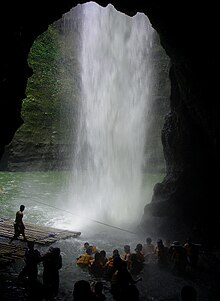Pagsanjan Falls
| Pagsanjan Falls | |
|---|---|

Inside the Devil's cave behind the waterfall
|
|
| Location | Laguna (province), Philippines |
| Coordinates | 14°15′45.32″N 121°29′59.86″E / 14.2625889°N 121.4999611°ECoordinates: 14°15′45.32″N 121°29′59.86″E / 14.2625889°N 121.4999611°E |
| Type | Plunge |
| Number of drops | 3 (one is hidden) |
| Longest drop | 120 metres (390 ft) |
| Watercourse | Pagsanjan River |
Pagsaŋjan Falls also known as Cavinti Falls (indigenous name: Magdapio Falls) is one of the most famous waterfalls in the Philippines. Located in the province of Laguna, the falls is one of the major tourist attractions of the region. The three-drop waterfall is reached by a river trip on dugout canoe, known locally as Shooting the rapids, originating from the municipality of Pagsanjan. The falls can also be reached from the top by a short hike from Cavinti. The boat ride has been an attraction since the Spanish Colonial Era with the oldest written account in 1894. The town of Pagsanjan lies at the confluence of two rivers, the Balanac River and the Bumbungan River (also known as the Pagsanjan River).
The main falls are actually located within the territorial jurisdiction of Cavinti, Laguna, approximately 3.2 Kilometers away from the boundaries of Cavinti and Pagsanjan, but the more popular access by canoes originates from the town of Pagsanjan. An ordinance was passed by the ruling body of the town of Cavinti was submitted to the Sangguniang Bayan (legislature of municipalities in the Philippines) on February 10, 2009 proposing the renaming of the falls to Cavinti Falls.
The falls and gorge were declared as a National Park with Proc. 392 on March 29, 1939 and Proc. 1551 on March 31, 1976. The Pagsanjan Gorge National Park covers an area of 152.64 hectares (377.2 acres).
According to history, the Pagsanjan Falls is rich in legendary lore. Long, long ago, recounts one legend, there were no falls. There were only the foliaged highlands, the twin rivers called Bumbungan and Balanac, and the alluvial delta where the town of Pagsanjan now nestles. On the eastern bank of the Bumbungan River lived two old brothers named Balubad and Magdapio. For many years, the two brothers enjoyed a rustic life of peace and happiness. But one day calamity struck. A terrible drought brought ruin and death; no rains came for successive months. The soil became dry as tinder. The blooming flowers and food plants withered and died. The birds, deer, wild hogs, monkeys, and other animals disappeared. The rivers, creeks, and mineral springs dried up. Not a single drop of life-giving rain fell from heaven.
...
Wikipedia
